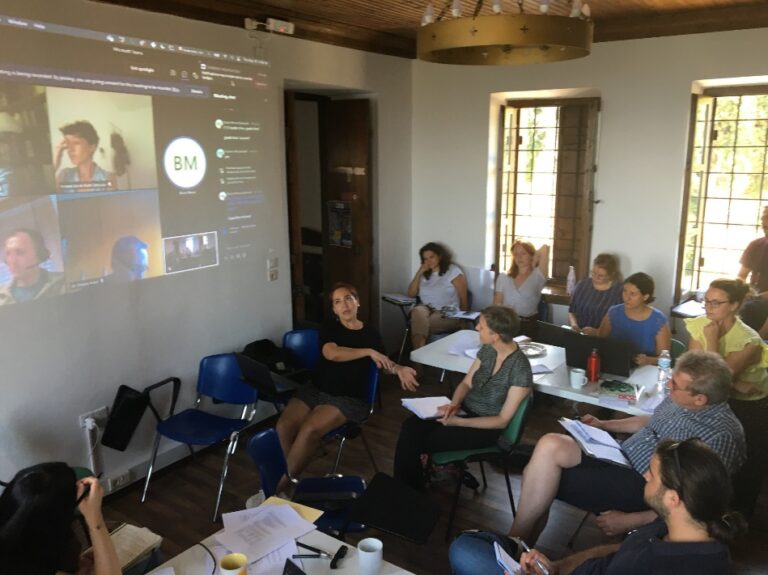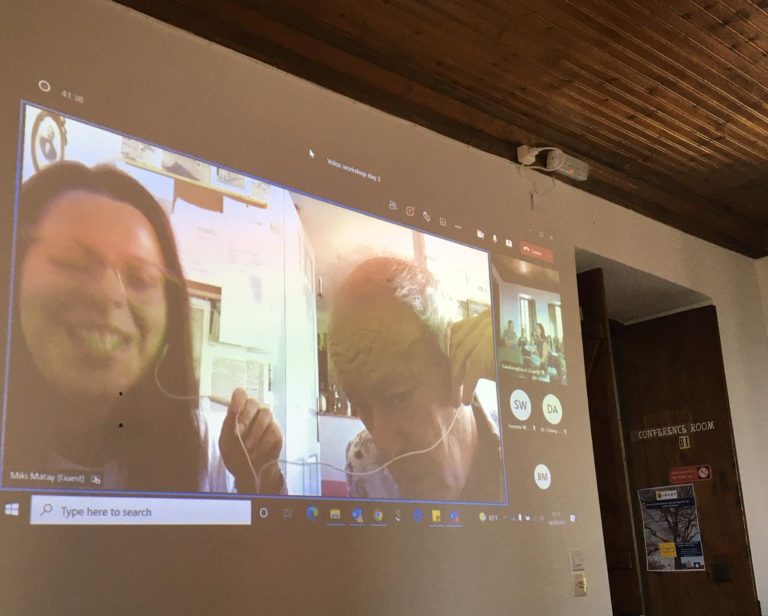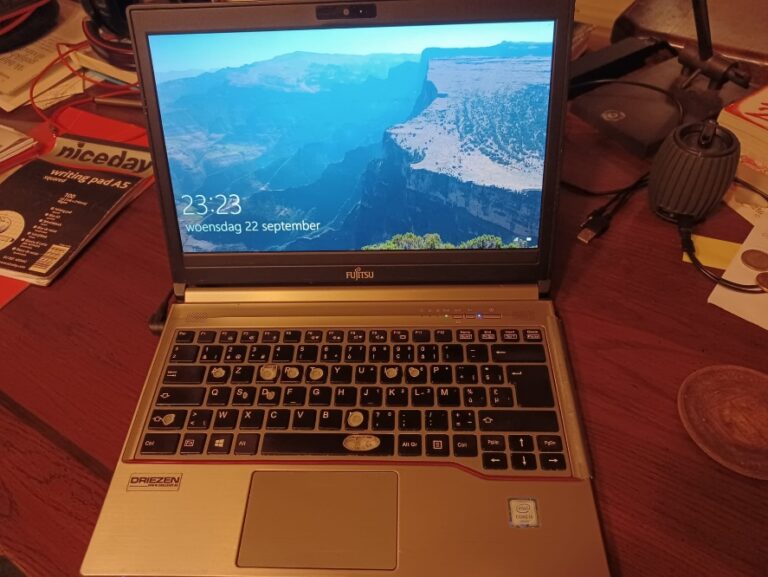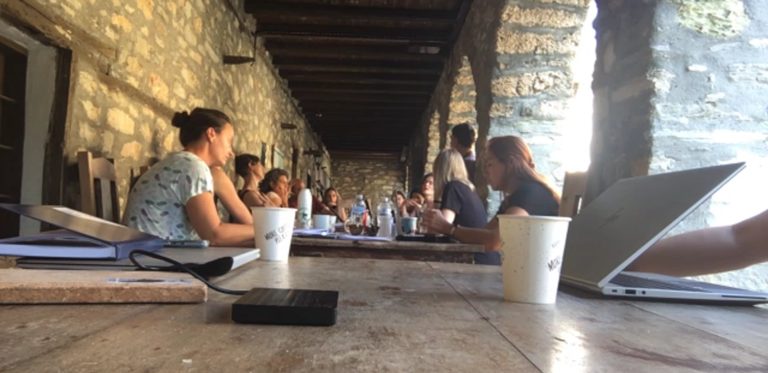Discussing future fieldwork in the Paou monastery. On Wednesday evening, technology was finally ‘under control’ and Marhabo, seated amidst an online and on-site audience could discuss her fieldwork in Istanbul in a relaxed hybrid setting
Unequal internet bandwidth in Europe. At the Paou monastery in Greece, average bandwidth was 14Mbps (down) and 1,3 Mbps (upload), which is not far from the regional average: in the village of Argalasti (where Paou is located), the bandwidth is on average 17,8mbps (down) and 2,2 Mbps (up) (Internet Speed in Europe (europeandatajournalism.eu))
Always use a headset to call in. Headsets filter out background noise and room echo.
Always carry a USB-stick to connect the material stored on the proverbial Fujitsu.
by Bruno Meeus
A few years ago, it was a quite revolutionary thing to ask the organisers of an academic meeting if you could give your presentation from a distance because of – for example – ecological, family or budgetary reasons. And it was even more difficult to ask a question or to expect to be really included in the discussion from a distance. The threshold to opt for an online rather than an on-site intervention now seems to have lowered because of Covid-19. Unfortunately, we are not there yet. For a fetishism is currently beginning to develop with far too much focus on razor-sharp images, high Wi-Fi speeds, dynamic cameras and what have you. A fetishism that leads to regular responses similar to: ‘no, a hybrid meeting is not possible’ and the piling up of ICT expenditures: ‘video conferencing cameras’ start at 1,000 euros, for the set-up of special hybrid conference rooms you do not get by on 5,000 to 10,000 euros. In what follows, I will first point out four important consequences of the exaggerated focus on ‘heavy equipment’ and then offer 10 tips for working with cheap and light equipment, as part of the general argument: ‘a hybrid meeting is always possible’. The tips are based on the experience of organising the first hybrid H2020 ReROOT meeting that took place between 11 and 18 September 2021 from the monastery of Paou in Greece. It is good to know that the technical preparations for this meeting had already been underway for a few weeks in order to avoid my own so-called technostress during the meeting, a form of stress I had been suffering from a lot during the past lockdown periods!
Why to avoid investing in expensive equipment
Images displace sound
The most logical effect of image fetishism: we forget the enormous importance of sound! There are now endless streamings, digital and hybrid meetings where the image is of high quality – where considerable investments have been made in the cameras – but where the central speaker is too far from the microphone, where someone’s laptop generates a continuous whistling sound throughout the meeting, where screaming feedback loops make you fear for permanent hearing damage, where the line of the microphone in the room is not linked to the softphone (Zoom, Teams, etc.) so that only the room can hear the speaker, etc. Of course there is the fact that you can quickly check whether you are ‘in the picture’, but that it is a lot harder to know whether something ‘sounds good’. Nevertheless, small adjustments – as I will indicate below – can make a world of difference. In Paou, where the image regularly slowed down or faded out, and where presentations kept ‘hanging’, it soon became clear that the meeting stood or fell with the quality of the sound.
Heavy equipment creates exclusions
Heavy equipment requires heavy equipment. Expensive cameras are useless in cases of lower Wi-Fi flows. It creates an unequal geography of well-connected places on the one hand, with all the necessary equipment in place for a ‘professional’ meeting and poorly-connected ‘amateuristic’ or ‘underdeveloped’ places where ‘a hybrid meeting is not possible’. This focus on images, on high flows, on well-equipped ICT rooms, means that a lot of participatory fieldwork in randomly Wi-Fi-ed meeting places seems impossible from the start. It reminds a bit of the image of the ‘business consultancy city’ Ash Amin is talking about in Telescopic Urbanism and the Poor: a networked but inward-looking exclusive urban world, the access to which is extended to ‘well-Wi-Fied’ homes, conference rooms, planes, fast trains etc.. On top of that there is the enormous amount of energy this heavy ICT-equipment requires.
Heavy equipment backgrounds maintenance work
Expensive and complicated technology means that, as a researcher, you soon think that the management of such a miracle belongs to the world of specialised logistic support, think: the technician in a dustcoat. That is a pity at a time when the divisive gendering, classing and racialisation of ‘thinking labour’ and ‘manual labour’ are increasingly under pressure. The work of the technician is unnoticed, unimportant, almost inexistent, when the meeting is going well1. The (job of the) technician only comes into the picture when something doesn’t work, or even worse, the technostress is then unloaded on the technician. The technician is then blamed for the failure of the meeting (instead of blaming the exaggerated expectations with regard to Wi-Fi and stability!)
Heavy equipment does not do your work
Expensive technology does not prevent voices from outside the room from being less ‘powerful’ in the conversation. An inclusive dialogue is not achieved by technology alone, but through the active shaping of equal speech positions using the technology at hand. Creating such an inclusive online/on-site platform for a conversation can only happen by actively monitoring whether all ‘stakeholders’ in the meeting are ‘on board’, both inside and outside the room, whether everyone can make themselves understood without being threatened and whether everyone can be heard. This requires a great deal of collective work that technology will not do for you – but which it can help you to do if you can manipulate it yourself.
10 tips based on the experiences in Paou
Tip 1: Use a headset to call in
Always speak through a headset (which can be simple earphones) when you are participating on-line in a hybrid meeting. A headset filters out a lot of background noise to begin with. Indeed, also in Paou, the sound of digital construction workers drilling through a wall somewhere else in Europe entertained the meeting for a while. And there is another advantage. Headsets cancel what is sometimes called ‘room’: the echo of your voice in the room where you are sitting. Even in a quiet room, speak into a headset rather than against the microphone of your laptop to project your voice more precise and direct. And that is important for the speakerphone we used in Paou (more about that in a moment). The speakerphone cancels echo, but does this best when the voice is well defined (and when you do not have an echo or ‘room’ of the room at home).
Tip 2: Use a speakerphone in the room and turn off all other sound!
The speakerphone is the miracle to bring every hybrid meeting to a good end very easily. In Paou, we used the cheapest speakerphone from Jabra which we connected to Teams via a laptop. All sending and receiving of images was organized via other laptops or phones. In such a setup we could ensure that there was at least a stable sound source during times when connectivity would fall under 1 Mbps. Talk to your ICT department and get yourself a cheap but decent speakerphone that you can plug into your laptop. With it, you can turn any meeting into a hybrid meeting where up to 25 people in the room – that was the situation in Paou – can participate. It is crucial that everyone else in the room who is logged into your Teams, Zoom or Skype meeting is fully muted. The best way is to mute via the hardware of the laptop: find the buttons on the keyboard to mute your speaker and microphone.
Tip 3: Chair with control over sound
Combine the role of chair with sound control, you can respond much faster to problems this way. Or divide the tasks in such a way that the chair and the person in control of the sound have constant visual contact in the room. When it is clear to everyone that you are in control of sound, you can immediately ask someone to speak louder or softer or to use a headset but also temper someone continuously dominating the discussion. In Paou, participants started coaching each other after a while. As chair in control of sound, you can open the microphone of someone who has been waiting a long time with a raised ‘old hand’ from a distance while listening to people convivially conversing in the room.
Tip 4: Designate avatars and always activate the chat
People from outside the room can designate someone in the room as an ‘avatar’, but you can also search for avatars yourself and attribute them in the room. In Paou, a number of people in the room got into the habit of keeping an eye on the ‘hands’ of the digital participants and signaling when someone from the digitals wanted to intervene. Of course, you can also encourage the people in the room to make parallel contact with those outside the room via Whatsapp or Signal or similar. The softphone’s chat function is essential for communicating with people outside the room: they can use it to launch their question, and as a chair you can give them guidelines without disrupting the discussion in the room. Moreover, the chat is the last resort if the sound fails. So make sure that the chat is always activated and in some way visible.
Tip 5: Avoid polycentric discussions at all times
It is almost inevitable that polycentric discussions will arise in larger groups. But avoid these conversations taking over, as this is completely unbearable for people outside the room, and certainly avoid these conversations being held next to or above the speakerphone. Again, messaging via Whatsapp and Signal are an elegant way of organising polycentric discussion in the room without disturbing the sound. Moderating is therefore very often pointing out to people that they are making it impossible for others to understand the conversation, and occasionally encouraging people to speak a little louder. Related to this: stimulate the people with the loudest voices to move a little further away from the speakerphone. This also applies to metaphorically loud (or dominant) voices.
Tip 6: Find a workhorse for streaming images
Although the start of my argument might suggest otherwise, I would like to emphasise that images are of course important. Capturing, sending and projecting images does, however, require a stable computer, especially when you are concatenating sessions of 2.5 hours in a row, as in Paou, where continuous streaming was organized between 9:00AM and 6:30PM. It quickly became clear that an everyday laptop could not handle that. Fortunately, there is always a geek around with a Mac and/or other robust computer and when you point out the exceptional ‘workhorse’ capacities of this computer to the owner, then it should not be a problem to let the images run through that computer. In Paou, that meant that a relatively old Macbook provided continuous projection from Wednesday onwards and the built-in laptop camera captured the audience. If you want more diverse viewpoints on the room, an external webcam – or a linked smartphone via the app EpocCam, for example – instantly expands the possibilities for visualising the room (but take 8 and 9 into account).
Tip 7: Make sure you have connectors for HDMI and VGA
Imagine a situation where people want to show a presentation from their own laptop. In Paou, we had two options, each time starting from the situation that you’re presenting with a shared screen in Teams (or Zoom or whatever). Either you present from Teams and someone else in the room projects your shared screen on the wall through Teams. In Paou, this option regularly failed so that nobody – neither the people in the room, nor the people at a distance – could see the presentation. What did work: connecting your own laptop through the projector in the room, logging into Teams, and giving the presentation for the room – directly to the projector in the room – and for the people at a distance with your screen shared in Teams. However, this also regularly ran into problems. Many laptops only have a port for HDMI or one for VGA or none at all. It is worth the effort to bring a few intermediate connectors to an event like this. But there is another solution.
Tip 8: USB connects the proverbial Fujitsu
While there is always someone with a Mac, there is also always someone with the proverbial Fujitsu, in this particular case a Fujitsu with a worn-out keyboard and taped CD-ROM port. In such a case of man-machine entwinement, a golden rule applies: USB is the master connector. Don’t try Wetransfer, Bluetooth or Airdrop or logging into Teams, but go straight for the USB stick.
Tip 9: Use cables when possible
You can connect the speakerphone to your phone or laptop with Bluetooth. This can be useful when, for example, you are filming with your smartphone and connecting to Teams, allowing you to capture the sound 6 metres away without having to worry about cables. In Paou, this turned out to be an excellent solution for streaming a workshop that took place around a long row of tables. But in most cases, it pays to be simple: with a minimal investment in an active USB cable, you can connect your devices 10 metres further without having to worry about the battery of your phone or speakerphone, or about disturbance of the Bluetooth connection as a result of interference of nearby refrigerators, microwaves, Wi-Fi routers and others.
Tip 10: Broadcast the presentation where the connection is most stable
And to end nicely on 10 tips: we discovered a final trick on day 5. When the Wi-Fi connection in the room is not that stable, ask someone else at a distance, with a stable Wi-Fi connection, to load the PowerPoint into Teams and present from there. It turned out to be piece of cake for the Dortmund team to give a duo presentation with someone on-site in Paou and someone on-line in Dortmund.
Extra: some statistics
At the Paou monastery, average bandwidth was 14mbps (down) and 1,3 mbps (upload), which is not far from the regional average: in the village of Argalasti (where Paou is located), the bandwidth is on average 17,8mbps (down) and 2,2 Mbps (up) (Internet Speed in Europe (europeandatajournalism.eu))
Here is a handy overview of bandwidth requirements for different forms of hybrid meetings (from sound to razor sharp images)
Microsoft Teams bandwidth requirements and other FAQs (2021) (checkmybroadbandspeed.online)





